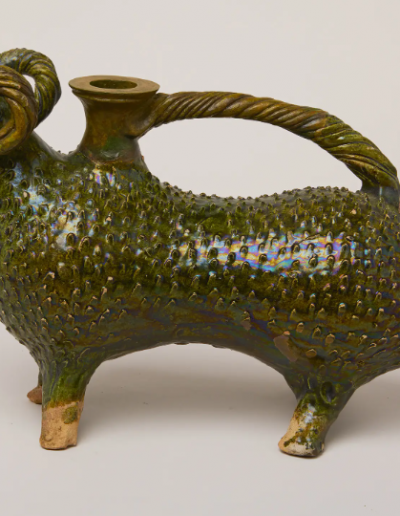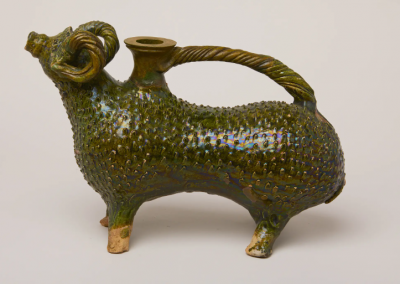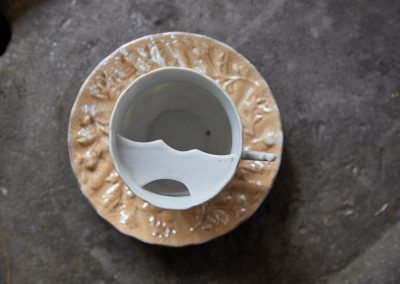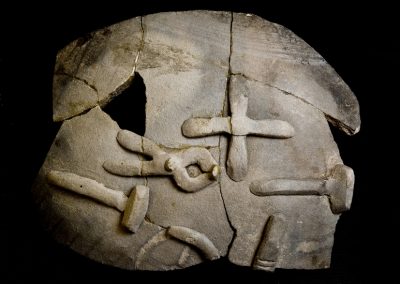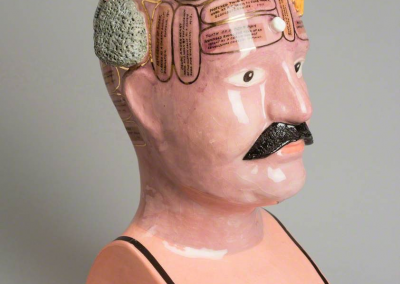Explore the Scarborough Ware of Scarborough Fair
You’re very likely to have heard the folksong ‘Scarborough Fair’, but what you may not realise is quite what Scarborough Fair was, or why it was important.
During medieval times, Scarborough on the North Yorkshire coast hosted an important annual trade fair for merchants. It was second in size and significance in the country only to London and was even granted a royal charter in 1253.
Lasting 45 days each year, the fair would have had a significant impact on the town’s economy. It was through the fair that ‘Scarborough Ware’ was able to reach a European audience, with merchants from as far as the Baltic, the Mediterranean, and the Low Countries attending. Medieval pottery-making was widespread, but most pots were sold to local markets. Scarborough ware is unusual for having much wider appeal.
Medieval ram-shaped aquamanile
From Rotunda Museum, Scarborough
Aquamanile is the word used to refer to ceramic water jugs, used during medieval times for pouring water for handwashing.
The name comes from the Latin words ‘aqua’ (water) and ‘manus’ (hand). They were particularly necessary in a time before running water and household taps.
Aquamaniles were often crafted in the shape of animals and known as ‘zoomorphic’ objects, like this one in the shape of a ram. The water was poured through the creature’s mouth. They were therefore not only functional but also served as amusing and decorative art pieces.
The ram’s horns have been created out of twisted clay, to match the handle, and small pellets of clay have been applied to the ram’s body in a way that imitates the texture of wool. Such skilful designs would have helped to showcased the craftsmanship of the period. Their distinctive green colour comes from the copper alloy glaze. Scarborough Ware dates from the 12th to the 14th centuries.
Fragment of knights-design jug
Scarborough Castle, English Heritage, courtesy of Scarborough Museums & Galleries
Though only the upper part of this large 13th-century jug remains, it’s still possible to identify this important piece of Scarborough ware. This green-glazed jug is decorated with knights riding on horses. Can you see one of their striking triangular shields?
Whilst for us today, the chivalrous notion of knights on horseback is now the stuff of fiction and romance, for medieval people it was an important part of culture. Within a feudal society, their roles involved defending lands and serving kings and lords. At the time when this jug was manufactured, knights were also still fighting ‘the crusades’ abroad. Being a knight was a mark of social distinction. The rituals of becoming a knight, including a ‘dubbing’ ceremony, were steeped in religious and cultural significance.
Sadly, complete examples of these knight-design jugs are exceptionally rare.
Explore an example that travelled further
This very rare complete example was found in Dartford and is now in the Walters Art Museum (available through a creative commons license), though it has had some restoration work. Around the jug, four knights chase a stag. Its antlers can be seen up the length of the spout. Click to enlarge it.
Fragment of jug with bearded face
Scarborough Castle, English Heritage
Scarborough’s pottery industry developed from the time of the reign of King Stephen (1135–54), when Scarborough Castle was founded, and lasted until the 14th century. This fragment is likely from a 13th century jug.
As well as animal designs, jugs with faces, like this, are also thought to have been popular. This section is part of a decorative rim from a tall jug. The beard was applied to the jug so that it sticks out.
(Object number – 88257197)
Activity – coming soon
Complete the design. What did the rest of the jug look like?
Talking Points
Had you heard of Scarborough Fair? What did you think it was?
Why do you think Scarborough Ware was popular across Europe?
Why do you think it’s rare to find complete examples like this?
Why do you think Scarborough was well placed for hosting an important medieval trade fair? What geographic features would have helped it to become established?
The aquamanile
Examine the aquamanile closely. What design features has the maker included?
How have the horns been made to match the handle?
How do you think the maker has created the texture of the ‘woolly’ body?
Were you surprised that this object is around 700 years old?
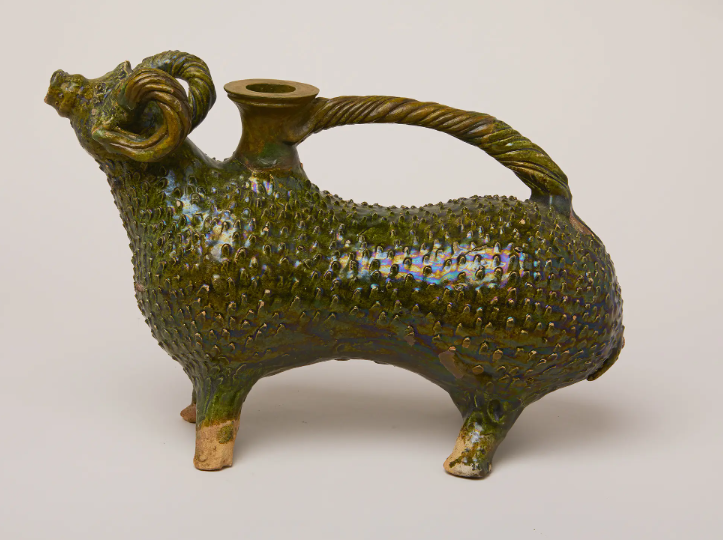

The fragments of Scarborough Ware
Why do you think these fragments of pottery have been kept, even though they’re broken?
What do you think the rest of the jug looked like?
What do you think the jugs were used for?
Why do you think knights were a popular design for Scarborough ware?


Vocabulary
Aquamanile: a type of medieval water jug, from the Latin words ‘aqua’ (water) and ‘manus’ (hand).
Zoomorphic: representing the forms of animals
Glaze: the glassy coating applied to ceramics. This makes ceramics more watertight and also adds decorative effect
Chivalry: the medieval knightly system with its religious, moral, and social code of behaviours
In the Classroom
Role Play
Imagine a very rare piece of Scarborough ware pottery has come up for sale – base the piece on one of the examples on this page. Hold an auction with your group taking on the roles of auctioneer, potential buyers and the journalists watching.
How will the auctioneer describe and market it? What price will it fetch and will it be going to a gallery or into private hands? Will it stay in Scarborough or go further afield somewhere?
Hands on History
You can see the aquamanile on display at the Rotunda Museum in Scarborough.
Find out more about their school education workshops.
Book a free self-led visit to Scarborough Castle and organise your day to suit your curriculum objectives, or book an immersive Discovery Day led by a member of staff.
Click on the pins on the maps to find out more about the heritage sites that feature these objects.
Explore more ceramics

